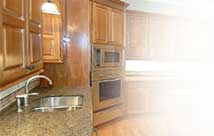Cabinet Replacement: Greening the kitchen with eco-friendly cabinetry
| Tweet |
"Incorporating green elements into a kitchen remodel is no longer considered just a passing fad, but a way of life," says Dick Titus, executive vice president of the Kitchen Cabinet Manufacturers Association (KCMA). "Homeowners feel a social responsibility to choose products that are safe for the environment and their family's welfare."
Kitchen cabinets could take up as much as half of a kitchen renovation budget, so it's vital for homeowners wanting to "green" their kitchens to choose a quality cabinet manufacturer with roots in environmental sustainability. KCMA's Environmental Stewardship Program (ESP) can simplify the quest.
ESP encourages the following practices by awarding points to manufacturers who qualify:
Certified by a recognized sustainable forestry program
Wood products, especially cabinets, are an environmentally friendly choice for a number of reasons. One reason is that wood is a naturally renewable resource, meaning new trees will grow in place of those that have already been harvested. ESP certification awards points to manufacturers who use wood in their cabinets that is certified through a recognized sustainable forestry program. Programs such as the Forest Stewardship Council (FSC) and Sustainable Forestry Initiative (SFI) put a label on their wood products to show consumers that the resources removed from the forest are at a level the forest is capable of renewing without damaging its future. In doing so, these practices preserve the environment and valuable forest resources.
Use of materials with low levels of formaldehyde
To earn points in ESP's air quality category, manufacturers must prove that 80 percent of particleboard, medium density fiberboard, hardboard and plywood used in the cabinets meet the low formaldehyde emissions level of the California Air Resources Board (CARB) Compwood ATCM. Such materials must be third-party certified by a CARB-approved lab to meet low formaldehyde emission standards. The CARB Compwood ATCM is the lowest formaldehyde standard in the world. Formaldehyde is a naturally occurring substance that can be produced by the human body. It is ubiquitous and a component of hundreds of consumer items.
Eco-friendly manufacturing process
When shopping for eco-friendly cabinets, it is important to not only examine the cabinets, but also the process that was used to manufacture them. Criteria for process resource management includes that the manufacturer have an active recycling program for wastes, an energy-conservation program or another form of environmental-management system. On top of conserving resources, these practices can reduce the emission of pollutants and greenhouse gases, and aid in decreasing landfills, all of which have clear societal benefits.
Commitment to the environment and community
When purchasing ESP certified cabinets, homeowners can rest assured that the manufacturer is committed to both the environment and their community. ESP's environmental stewardship criteria require that the manufacturer have a written policy stating a firm commitment to protect the environment. The community relations category encourages the manufacturer to demonstrate community involvement and leadership through service or charitable organizations and observe all federal, state and local environmental requirements.
With almost 150 ESP certified cabinetry companies to choose from, homeowners have the ability to select environmentally responsible cabinetry tailored to their needs, no matter their price, style, finish and wood preference - just look for the ESP seal located on the base cabinet. For more information and tips on "greening" the home and finding environmentally friendly cabinetry visit www.greencabinetsource.org.
Courtesy of ARAcontent.


|
Respond Home Improvement Directory lists the top Kitchen Cabinet Contractors in your area, organized by specialty and office location. |
| Top Cities | |
|
Atlanta
Chicago New York |
Los Angeles
Philadelphia Washington DC |
| Canadian Cities | |
|
Calgary
Edmonton Ottawa |
Toronto
Vancouver Winnipeg |





